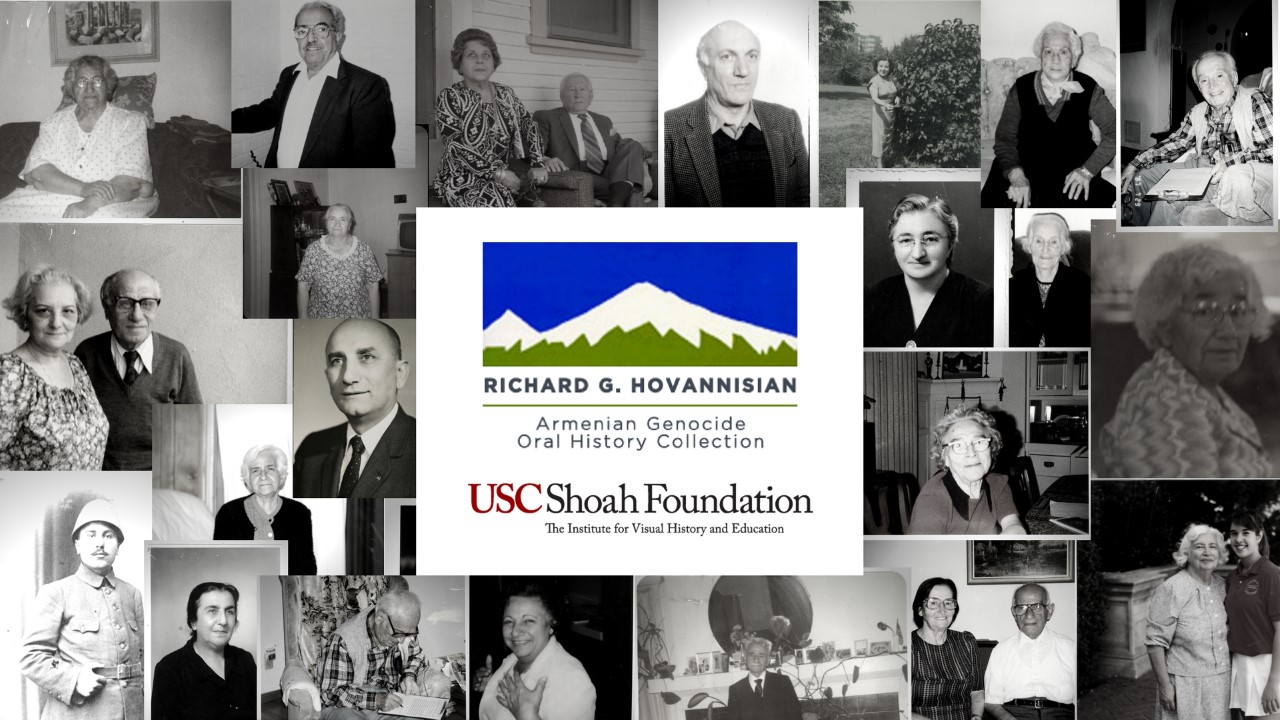“Preserving History: Armenian Voices from the Classroom to Archive” by Richard Hovannisian (Professor Emeritus of History, UCLA), March 5, 2019 (lecture summary)

On March 5, 2019, the USC Shoah Foundation Center for Advanced Genocide Research and the USC Dornsife Institute of Armenian Studies had the pleasure of hosting Dr. Richard Hovannisian, Professor Emeritus of History at University of California, Los Angeles. Professor Hovannisian presented on the history of his Armenian Genocide Oral History collection, which is today part of the USC Shoah Foundation Visual History Archive. Considering that this collection was created as part of two courses that Professor Hovannisian taught at UCLA over five decades, three of his former students – Salpi Ghazarian, Tamar Mashigian, and Lorna Touryan Miller – also spoke about their experiences of conducting interviews with Armenian genocide survivors.
Professor Hovannisian opened the lecture by reflecting on his personal background. As a first-generation Armenian American born in the United States after the Armenian genocide, he grew up in California surrounded by both Armenian genocide survivors who had immigrated to the United States in the aftermath of genocide, as well as Armenians who moved here before 1915. Professor Hovannisian remarked that there were two kinds of survivors in his community: those who kept their stories to themselves until the last years of their lives, like his father, and those who talked about their experiences so often that their relatives absorbed their stories. However, he noted that his generation did not want to have much to do with the genocide, and they, including himself, wanted to distance themselves from the experiences of their parents.
Upon his move to Fresno, California, Professor Hovannisian realized that all the Armenians who lived there had a story to tell. Years after, when he started his work at the University of California, Los Angeles, Professor Hovannisian came back to Fresno only to realize that all the Armenians who lived there had passed away This discovery inspired his project of collecting oral histories of Armenian survivors of genocide, which started as part of his course on immigration at UCLA, and continued through his another course on Armenian oral history in the 1970s. Professor Hovanissian noted that it was not easy to reach out to survivors at that time, and most of the interviewees that he and his students were able to recruit were young mothers and child survivors. Through these two courses, Professor Hovannisian trained his students in oral history methodology, and they interviewed ten survivors per year. Reflecting on the mixed quality of interviews in the collection, Professor Hovannissian ended his remarks by pointing out that the strength of testimony lies in the collectivity of it, that is, in the collectivity of voices they were able to collect over time.
Presentations by Professor Hovannisian’s three former students filled the second part of the event. Salpi Ghazarian – the granddaughter of a survivor herself – noted that with this project, Professor Hovannisian enabled her and her peers to gather details about personal experiences of the genocide and to ask survivors questions that nobody else asked. For Ghazarian, conducting these interviews was more about understanding the depth and scale of loss, than about preserving survivors’ stories. In addition, she pointed out that many survivors she interviewed did not know how to share their trauma, and the very impact of trauma on them was immense and lasting. Ghazarian stated that Professor Hovannisian’s legacy continues through the USC Dornsife Armenian Institute’s program in oral history.
The second former student to present was Tamar Mashigian. Like Ghazarian, Mashigian is also a granddaughter of genocide survivors, and she reflected on her grandparents’ story of survival and escape from an Arab tribe where her grandmother was held captive for thirteen years. Mashigian started out by learning her grandparents’ stories first. While in Professor Hovannisian’s class, Mashigian was able to refine her interviewing techniques. She recounted the content of their interview questionnaire at the time and remembered the challenge of overcoming survivors’ habit of focusing solely on their experiences during the genocide and neglecting the pre-genocide and post-genocide details from their lives. To conclude, Mashigian highlighted the importance of the USC Shoah Foundation’s work.
The final presenter was Lorna Touryan Miller. Both her parents were genocide survivors. Her father was the only one who survived from his family, and once he became seriously ill, she and her husband started interviewing him to record his story. This story led them to recording the stories of 200 other survivors of the Armenian genocide. After she had interviewed the first 20 survivors for their project, Miller took Professor Hovannisian’s class to learn how to conduct oral history interviews. Ultimately, Lorna Miller and her husband, Donald Miller, translated, transcribed, and coded all the interviews they conducted, and published their book Survivors: An Oral History of the Armenian Genocide (1999). All the interviews were conducted in Armenian with survivors who averaged between 11 and 20 years old at the time of the genocide. Miller noted that giving interviews was a cathartic experience for many survivors. In addition, she remembered many of them being very emotional, but also expressing rage and anger about what had happened. Finally, she said that her subsequent work with the Tutsi survivors of the Rwandan genocide helped her reflect on the significance of her work with the Armenian survivors.
The lecture was followed by a Q&A session. Some of the questions included whether Professor Hovannisian anticipated to continue with his class for as many years as he did; whether the interviews in the collection were available to researchers over the years; Professor Hovannisian’s relationship to Michael J. Hagopian’s project; the existence of any project focused on Islamicized, hidden Armenians who want to know about their roots; and they ways in which the presenters would like these interviews to be used in the future.
Summary by Badema Pitic
Like this article? Get our e-newsletter.
Be the first to learn about new articles and personal stories like the one you've just read.